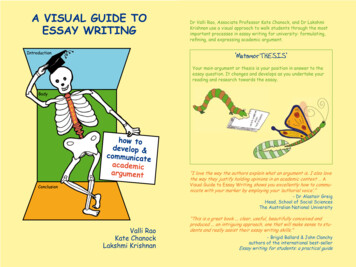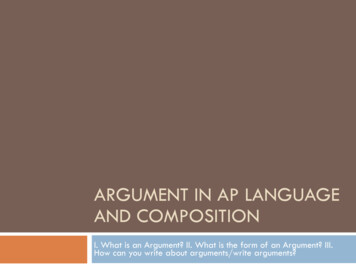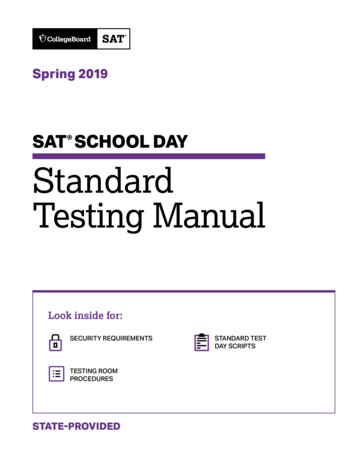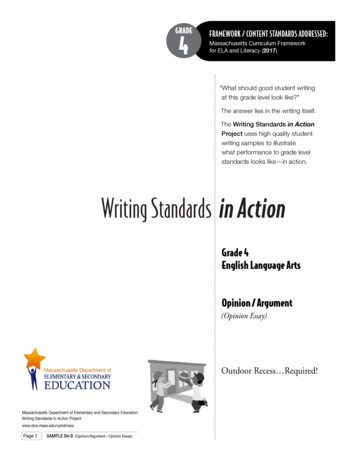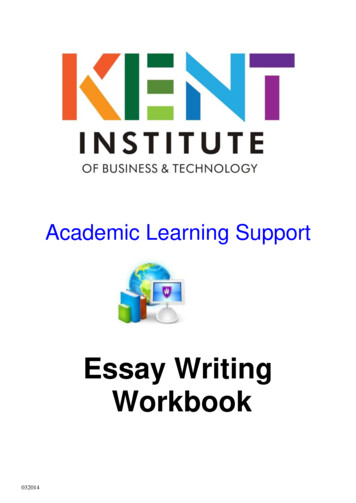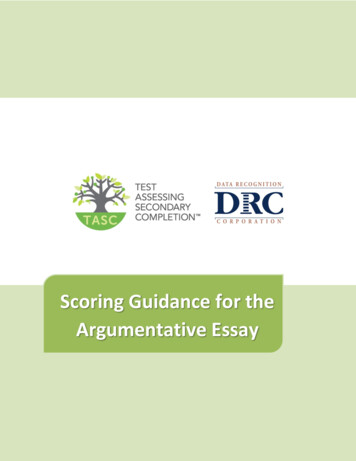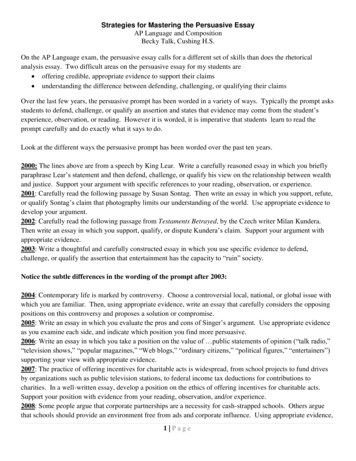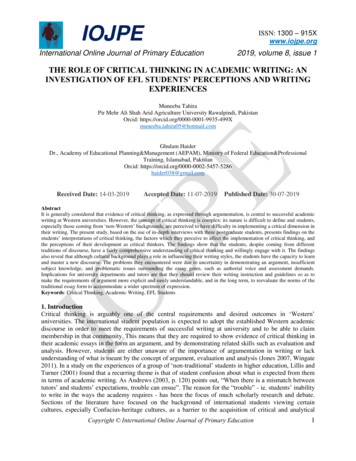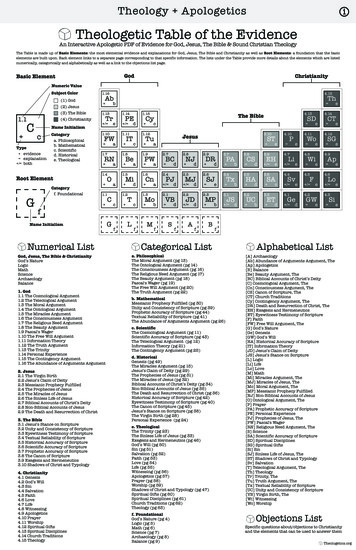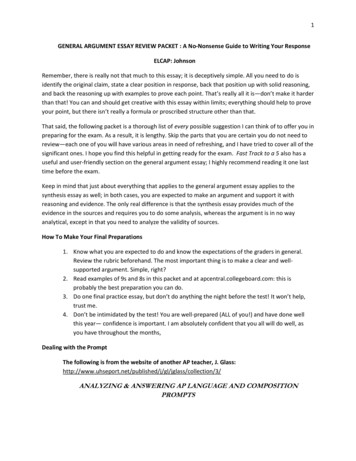
Transcription
1GENERAL ARGUMENT ESSAY REVIEW PACKET : A No-Nonsense Guide to Writing Your ResponseELCAP: JohnsonRemember, there is really not that much to this essay; it is deceptively simple. All you need to do isidentify the original claim, state a clear position in response, back that position up with solid reasoning,and back the reasoning up with examples to prove each point. That’s really all it is—don’t make it harderthan that! You can and should get creative with this essay within limits; everything should help to proveyour point, but there isn’t really a formula or proscribed structure other than that.That said, the following packet is a thorough list of every possible suggestion I can think of to offer you inpreparing for the exam. As a result, it is lengthy. Skip the parts that you are certain you do not need toreview—each one of you will have various areas in need of refreshing, and I have tried to cover all of thesignificant ones. I hope you find this helpful in getting ready for the exam. Fast Track to a 5 also has auseful and user-friendly section on the general argument essay; I highly recommend reading it one lasttime before the exam.Keep in mind that just about everything that applies to the general argument essay applies to thesynthesis essay as well; in both cases, you are expected to make an argument and support it withreasoning and evidence. The only real difference is that the synthesis essay provides much of theevidence in the sources and requires you to do some analysis, whereas the argument is in no wayanalytical, except in that you need to analyze the validity of sources.How To Make Your Final Preparations1. Know what you are expected to do and know the expectations of the graders in general.Review the rubric beforehand. The most important thing is to make a clear and wellsupported argument. Simple, right?2. Read examples of 9s and 8s in this packet and at apcentral.collegeboard.com: this isprobably the best preparation you can do.3. Do one final practice essay, but don’t do anything the night before the test! It won’t help,trust me.4. Don’t be intimidated by the test! You are well-prepared (ALL of you!) and have done wellthis year— confidence is important. I am absolutely confident that you all will do well, asyou have throughout the months,Dealing with the PromptThe following is from the website of another AP teacher, J. s/collection/3/ANALYZING & ANSWERING AP LANGUAGE AND COMPOSITIONPROMPTS
2Your task: to determine exactly what the test writers expect from your essay and then to meet theirexpectations using academic English and advanced-level syntax.Your challenge: to perform this task in only 40 minutes per essay.Below are some tips that should help you use your limited time efficiently.ANALYZING THE PROMPTSTEP ONE: Underline key words and phrases in the prompt. Begin with verbs such asidentify, analyze, describe, compare and contrast defend, challenge, and qualify*.*Usage note: If you would like to qualify an author’s claim, do not write “I qualify with thisclaim ” Qualify does not take the preposition “with.” “I qualify so-and-so’s claim that ” is alsoless than ideal.How can you express that you would like to qualify the author’s claim and still avoid the 1st personpronoun “I”? Write a thesis statement that specifies the extent to which you agree with the authorand why.STEP TWO: Paraphrase in your own words what you are expected to do. You can do somentally and silently. Here is an example of this kind of internal paraphrase: “What I need to dois look for diction, rhetorical devices, and other literary techniques in this piece that help show howthe author feels about Topic X. I have to be able to describe the tone and explain how certainrhetorical strategies create this tone.”STEP THREE: Where applicable, read the text you will be writing about carefully and withthe prompt in mind. You may notice many interesting aspects of the text that will not help yourespond effectively to the prompt. Do not focus your energy on them. For example, if the promptasks you to focus on how an author uses rhetorical strategies to convey his/her attitude about TopicX, do not worry about creating a laundry list of every single scheme and trope in the passage used todiscuss Topics Y and Z. Instead, focus on the aspects of form that contribute to the tone used todiscuss Topic X.ANSWERING THE PROMPTTIP #1: Take the time to pre-write in whatever way works best for you. Yes, your middleschool teachers probably made you go through painful and rigidly formulaic pre-writing activities,and these activities wasted your time. But that does not mean that you should abandon pre-
3writing altogether. Many students at UHS tend to jump right into an essay, and admittedly,sometimes it works well, but all too often, these students, who have excellent ideas to share, losetrack of the prompt and produce off-topic, rambling, repetitive, or unfocused essays with no clearthesis. I’ve seen ample evidence this year to support the following claim: Students who dotake the time to pre-write and who actually consult their notes/outlines/webs, etc., as theywrite, produce better organized essays that are clearer and more concise.The AP readers like clear and concise. Many 8’s and 9’s are short, but they are all well-organized,well-developed and unified by specific and sophisticated thesis statements. Repetitive and/orunfocused essays have a difficult time making it into the upper range of scores.TIP #2: Do not write an “empty” introduction that sounds nice but does not say anythingrelevant to answering the prompt. More specifically, avoid simply repeating or rephrasing theprompt. In addition, avoid sentences like this one: “Since the beginning of time, orators and authorshave expressed their opinions through the use of rhetorical strategies.” You don’t have time to bevague, nor do you have time to outline the history of rhetoric; begin answering the promptimmediately.TIP #3: Consider leaving the introduction until last. Many talented authors “write tounderstanding” and discover what they are really trying to say while writing the body of an essay; ifyou are one of them, you might want to write the body paragraphs first.TIP #4: Once you’ve begun writing, be sure to periodically check that you are staying onprompt. If you have strayed, do whatever you need to do to re-focus your essay. AP readers donot frown upon cross-outs, inserted sentences indicated by arrows, or similar evidence ofediting. In addition, they reward students for what they do well in terms of answering the prompt.Therefore, you are better served by getting back on track quickly than by writing an eloquent offtopic essay.TIP #5: If you have to make a choice between a skimpy last body paragraph and a skimpyconclusion, choose the skimpy conclusion. It is more important to have fully developed your
4body paragraph. Many upper-range essays have short conclusions; focus on the heart of youranalysis.TIP #6: Show off your command of academic English. While you should avoid wordiness, youshould also demonstrate that you can write at the college level. Demonstrate to your readers thatyou have at your command an advanced vocabulary, a knowledge of how to use semi-colons, theability to vary the beginnings of your sentences, and other marks of an advanced-level writer.Remember that the difference between a 6 and a 7 or an 8 and a 9 is often the sophistication of theprose. If at all possible, leave yourself a few minutes to proofread your essay for informal dictionand errors in conventions and to make any necessary changes.MORE ON PROMPTS AND THE EXAM FORMAT:General Exam FormatMultiple Choice :Section I% ofGradeNumber ofQuestionsMinutes Allotted4555 (approx.)603135 (includes 15 “added” minutes for readingthe synthesis question materials)Essays: Section II 55What the Essay Prompts Look LikeThe types of questions asked vary from year to year, but you will likely see A. One question that asks you to take a stance on an issue1. very open-ended: you choose the issue2. more directed: defend, challenge, or qualify the claim of another authorB. One question that involves rhetorical analysis of a prose passage1. focused on how writer conveys attitudes2. focused on how author makes the text persuasive3. focused on comparison/contrasta. elements within a single textb. two short texts on similar topics or by the same authorTIP: The endings of passages are important and warrant careful reading. Often the authorresolves an inner conflict, summarizes his/her position on an issue, or otherwise revealssomething important for your understanding of the passage as a whole in the finalparagraph or sentence.
5C. One synthesis question that asks you to support your own argument using short source“documents”1. stating clearly your own, convincing thesis very important2. sources will be 4 to 7 in numbera. at least one visual image1) photograph2) cartoon3) graph4) pie chart3. need to cite and discuss at least three of the sources in your essaya. MLA citation may not be necessary, but is helpful4. possible relationships among the source textsa. similar opinionsb. (diametrically) opposed stancesc. elaborationClaim First off, you need to identify the claim in the text to which you are to respond. Usually,you will be given a short quote. Usually there is not more than a paragraph or two oftext. Immediately identify and mark the claim of the author. Keep the claim in mind asyou complete the rest of the essay! Identify the author’s reasons for the claim, if there is enough text to do so. This helpsyou to determine whether or not the reasons are valid, sound, and true. This in turnhelps with concession, refutation, and the like. Make a claim and stick to it throughout the writing. This does not mean you cannotchange your point of view over the course of writing and thinking, but your final claimshould be clear and definitive. Qualifying the claim should only be a last-resort approach; don’t qualify the claim as awhole unless it’s absolutely necessary. Effective qualification is very difficult, andqualified arguments tend to sound wishy-washy and unsure at times. Feel free to change your claim in the process of thinking about both sides of theargument; however, make sure that your ultimate conclusion is clear and accuratelystated. Address exceptions and limits to your claim: if there are certain circumstances underwhich your claim does not apply, be sure to point them out, rather than ignore them.Also, be sure to explain why your claim is not invalid as a result of these circumstances.
6 Clarify the extent of your claim: does your claim cover all time periods, religions,cultures, professions, etc.? Is it universal, or is does it depend on circumstances? Beclear about these factors; your reader will want to know! State your claim clearly and in the active voice. Avoid qualifying modifiers, but equallyavoid overly general, excessively abstract, or inaccurate absolute terms and phrases.Audience Treat your audience as a group of intelligent, rational individuals with varying biasesand beliefs on the topic at hand. If you recognize various possible biases on the issuesand address the consequences, you really can’t go wrong. Any audience wants to betreated with dignity—avoid “talking down” to the audience and oversimplifying points. Your ethos: strive to come across as open-minded but assured of your views. You wantto project the appearance of having considered all sides of the argument and weighedthe specific merits and drawbacks of each. You also want to seem intelligent and wellinformed, capable of choosing between the various perspectives in order to select themost appropriate side to any issue. You do not need to come across as especiallybrilliant, gifted with words, or the like. The success of your argument is more importantthan the appearance of overwhelming brilliance!Time Considerations Number of exampleso Fewer can be better: 2 or 3 well-chosen, well-developed, specific examples isoften preferable to, and more efficient than, giving tons of examples that allprove the same thing but in less detail.o BUT—Use enough examples to fully prove the point.o The best proof is often in the detail of the examples—don’t trade anything forthe development of your examples! You may be faced with the need todispense with the conclusion or risk under-developing an example. Realize thatthe graders know the time constraints. You will be rewarded more forsupporting your argument well than you will be for merely meeting thesupposed expectations of a conclusion. In short, examples and proof are moreimportant.o Use enough to suggest that the examples “cover all bases.” Use examples thatshow all of the important and relevant aspects of your argument. If your claimhas multiple parts or “prongs,” make sure you provide thorough evidence foreach. Prewriting: Do it, certainly, but keep it quick and simple. Listing (“brainstorming”) tendsto be effective. (pro) and –(con) t-charts can also help to set you up to consider theother side in order to provide refutations and concessions. Revising: Yes, you will be under rather strict time constraints. That said, there is toomuch to be gained from re-reading and revising your essay to ignore it. You will often
7see gaps and holes in your argument that you did not see the first time through—thegraders will notice these holes, so go back and fill them in! Take time especially to addfurther elaboration of examples. Use the “so what?” and “depth-charging” strategies,especially.Evidence Contextual considerations:o To what extent or degree do your reasons and examples apply? Are there anycircumstances in which your claims and support do not apply? If so, it is oftenvery useful to acknowledge the potential shortcomings of your argument: doingso helps you to avoid coming across as biased against one point of view oranother, or against a particular idea.o Are your reasons and examples sufficient to prove that your claims areaccurate regardless of place or time, or, if they are limited by place and time,have you explained the limitations clearly?o Avoid taking on topics and ideas that you do not have the experience to speakwell over: the graders know, of course, that you are a high school student. Youprobably won’t fool them with a fabricated expertise in open-heart surgery.o Analogies and comparison/contrast are useful strategies for explaining ideas;make use of them! You can even get creative with metaphors, but make sure itis a fresh, clear, accurate metaphor that truly captures the spirit of thecomparison.o Cliches hurt your voice and your argument; stay away from them. Exampleso Scope: be sure to clarify for your reader the extent to which your examples holdtrue (see suggestions for “claim” above—all of the same suggestions apply toyour use of examples.)o Similarity of Examples: make sure all of your examples prove some aspect ofyour claim; sometimes this requires using similar examples, sometimes itrequires using examples from a broad range of backgrounds; let your argumentdetermine the degree to which your examples are similar.o Accuracy of Examples: a critical error many students make is in using examplesthat don’t really prove the point they are trying to make. I believe this occurs asa result of a lack of focus on the prompt and “forgetting” the main claim andreasons for the claim. If you keep your own claim in mind and consider how wellyour examples prove that claim, you can avoid slipping up in this area.o Avoiding Assumptions About Examples: be aware of your own biases and tryyour hardest to see things from the other side. This helps you to avoid assumingthat the lessons of a certain example are self-evident, and helps to ensure thatyou say enough to really convince the audience of the accuracy and validity ofthe example.
8 Types of Examples: your examples can come from just about anywhere, as longas they prove the point you are trying to make.o Personal examples: usually told as narratives or anecdotes. Be surewhen using personal examples to show that the lesson of the exampleextends to your audience and not just to your particular situation.o Historical examples: often provide excellent support if explained fullyand accurately. Make sure you know what you are talking about,though; most AP graders have an excellent grasp of history!o Current events and topics: again, very useful as a form of support.Make sure you know what you are talking about (it bears repeating!) Ifyou are not well-versed in the details of the example, don’t use it!o Literature: useful especially for exploring concepts and ideas. Be sure toshow that the example also applies to “real-life,” though; otherwise, theaudience may say “but it’s only a book ”o Film and TV: the same applies as with literature. Avoid pop cultureunless it’s highly relevant to the prompt.o Comparison and contrast: comparing and contrasting examples withyour thesis/claim in mind often helps to clarify most of the contextualand scope issues for your reader.o Analogies: these offer the same benefits as comparison and contrast.o Don’t leave any loopholes in your examples or explanations; this is onereason a t-chart is effective; it allows you to see potential gaps byunderstanding the views of the “other side” of the argument.Organization Review the Bruffee Patterns. Know them. Use them.o Straw man and one reason, two reasons, concession, Nestorian Order Think about your purpose; meaning dictates form. The structure of your essayshould help to contribute to the argument by providing logic and emphasis tothe important facets of your argument. Placement of paragraph breaks and transitional phraseso Topical and functional paragraphs—review notes in the “Strategies”section of your Writer’s Notebook; also available at my website. Makeuse of these for rhetorical emphasis and effect.o Paragraphs should generally be arranged according to related ideas.Examples will often need to be arranged in their own separateparagraphs, though this is not a hard-and-fast rule. Sentence organization; vary lengths according to emphasis. Remember thatthe end of a sentence is the position of most emphasis; use this to help you toemphasize your claims and important points.
9Clarity and Conciseness No wasted language, no wasted time, no wasted space—leave out anything that doesnot in some way contribute to the point that you are making. Every word shouldsomehow help to prove the point that you are making. Avoid “fluff”—graders can spot it from miles away. There is a fine but definite line between elaborating well in detail and amount andsaying too little with too much; know where the balance lies and strive to attain it.Voice Avoid needlessly academic, over-written prose; clarity is more important thananything, and style is easier and voice are much easier to achieve with a relativesimplicity of language—this is not to say that you should write informally, just that youshould keep your writing natural; avoid the temptation to try to write like a professor; itis transparent and destroys your credibility in the argument, which is a vital aspect ofsucceeding on this essay. Write in the active voice; take a minute or two to revise as needed (see your Writer’sNotebook “Strategies” section for tips on eliminating passive voice in favor of activevoice.) Sound sure of yourself. Leave out phrases like “I think” or “I feel”—these usuallyimpeded the confidence in the voice.o Phrases to avoid: “I think” “I feel” “Probably” “Sometimes” “Maybe” “I defend,” “I refute,” “I qualify,” and any variations of these phrases.These do not say anything to further your argument and constitute onlywasted pencil movement and time. Leave them out in favor of phrasesthat actively state your point; “Camus’ ideas are misguided because hemistakes the underlying uncertainty of the future for meaninglessness,”for example. Avoid vague, non-committal language; make clear judgments with clear reasoning There is nothing wrong with first person when used for a good reason in the contextof the argument. Be sure to use accurate language to describe an author’s claim; if you misrepresentan author’s idea, you are guilty of the strawman fallacy and your argument losesvalidity! Don’t stick too close to the passage used in the prompt. Concrete, specific, fullyelaborated examples are of primary importance to your argument—if you don’tsupport your ideas, they cannot stand up! Often, when students feel limited to
10 writing about the prompt passage directly leads to summary instead of argument,and this will earn you at best a 2.Prove that your examples show what you suggest that they show and prove whatyou say they do. This requires multiple “tiers” of evidence (see J. Glass attachmentin this packet)Be careful to layer your argument with these tiers so that you have sufficientsupport and explanation for your ideas.Remember the “so what?”, “what/how/why” and “depth-charging” strategies?They all work for this essay, too (especially depth-charging!)Focus on providing the details and specifics that help to prove your point; sayingmore for the sake of saying more isn’t the point; the goal is to provide relevantcontext. In this, you can also use SOAPS from a writer’s perspective; when youexplain an example, you can use the SOAPS acronym as various points to beexplained for each example—this may help you remember to “flesh out” yourexamples sufficiently.DO NOT write about anything you don’t know about. A lack of knowledge is almostimmediately obvious in essays—you won’t fool the grades, since they readthousands of these essays and are trained in looking for weak and fallaciousarguments. Don’t put yourself in position for a weak or fallacious argument byspeculating, avoiding directly dealing with the issues in the prompt,There is no need to directly refer to the prompt in your response; refer instead tothe passage.Your thesis may appear nearly anywhere in the essay, as long as it makes sense foryour purpose and is clear.BELOW ARE TWO ARTICLES FROM AP CENTRAL THAT ARE WORTH THE TIME TO READ: THEY OFFERGOOD ADVICE FROM THE GRADERS THEMSELVES!Shaping Argument: Lessons from 2003 Exam Samplesby Renee Shea, Bowie State University, Bowie, MarylandMost of us who teach have encountered the paradox that students are ferocious when it comes tohaving opinions but less confident when trying to express them as written arguments. Many of themturn to the five-paragraph formula, stringing together a series of examples. What other options do theyknow that they have? To explore this topic, I studied a group of sample essays from the following 2003argument question:The Prompt: Free-Response Question 1, 2003 AP English Language and Composition ExaminationIn his 1998 book Life the Movie: How Entertainment Conquered Reality, Neal Gabler wrote thefollowing:
11One does not necessarily have to cluck in disapproval to admit that entertainment is all the thingsits detractors say it is: fun, effortless, sensational, mindless, formulaic, predictable, andsubversive. In fact, one might argue that those are the very reasons so many people love it.At the same time, it is not hard to see why cultural aristocrats in the nineteenth century andintellectuals in the twentieth hated entertainment and why they predicted, as one typicalnineteenth century critic railed, that its eventual effect would be "to overturn all morality, topoison the springs of domestic happiness, to dissolve the ties of our social order, and to involveour country in ruin."Write a thoughtful and carefully constructed essay in which you use specific evidence to defend,challenge, or qualify the assertion that entertainment has the capacity to "ruin" society.I chose samples that received a score of 8, which, according to the scoring guide, "recognize thecomplexity of the claim that entertainment has the capacity to 'ruin' society and successfully establishand support their own position by using appropriate evidence to develop their argument." The "8"papers don't have the sophistication or fluency of the "9" papers, but they are excellent -- in many ways-- models of argument.*Yes/No . Then List ExamplesAccumulation of evidence is by far the most common approach, a kind of reverse induction: the writeragrees or disagrees and cites examples to support that categorical position. Typical is the student whowrites "Gabler's theory . has been proven true by historical falls of empires, literature, and modern-daysociety." What follows are three rather lengthy paragraphs, each developed with an example on one ofthe specified topics: the fall of Rome, Shakespeare's Henry IV, and computer video games. It is a fourpage essay with five paragraphs.Another student challenges Gabler with this thesis: ".in most instances of 'risky' books, movies, andplays, entertainment . has something to offer beyond the cover that most people are not willing to lookfor." The writer then develops an essay with a paragraph about Broadway plays, specifically The FullMonty; another on books, specifically Huck Finn; and another on movies, with reference to John Waynewesterns, Psycho, and A Beautiful Mind. Perhaps somewhat more subtle than the previous response,this one is also a five-paragraph essay driven by examples.Of course, we tell students to support their arguments with examples, emphasizing that the mosteffective essays are concrete and specific, developed with relevant details. But the responses that followthis pattern are essentially one-point essays -- the same point, "I agree or I don't," supported by threedifferent examples or types of examples to make that point. I often tell my students that this kind ofessay strikes me as the verbal equivalent of raising one's voice: with each example, the volume goes up,yet the same point is repeated. Given the scores, however, it's clear that this approach can work well.It's a safe one, though the essays lack nuance.Form and Substance
12I noted three other patterns as I studied this pool of samples, though none as prevalent as the exampledriven form: (Re)Definition, Consequence, and Yes . But. In each of these other approaches, thewriters subordinate their supporting examples to subassertions or claims. The pattern then becomesagree/disagree, discuss a series of issues related to the stated claim, and support with examples orfurther explanation. It's worth noting that some of these are also five-paragraph essays, yet they are notas one-dimensional because the arguments are more layered.The point that struck me as I read over these essays (all receiving the same score) is that theaccumulation-of-evidence approach is not wholly ineffective; in fact, it's a clear method of organization,but it locks the writer into a static argument because the structural template seems to drive thethinking. The writers do "establish and support their own position by using appropriate evidence," oftenwith considerable fluency, but the arguments are less developed than simply asserted, and thenhammered away at. In the other three patterns, I found students "questioning the question," as theargument developed more of an organic life of its own that reflected several levels of critical analysis.(Re)DefinitionMost of the student writers assume that entertainment is a synonym for television and movies(probably because of the title of Gabler's book), but some recognize the importance of defining the termprecisely, using that process to structure the essay. One such student asserts: "Though oftencontroversial and viewed as 'mindless,' entertainment positively contributes to society and enrichesrather than ruins our society." Neither assuming that we equate entertainment with violent films andmindless television nor accepting the binary opposition of entertainment and reality, he structures hisessay by examining alternative definitions of entertainment as, first, education ("an especially potenteducational tool due to its ability to combine fun and learning"). He discusses that point and includes -but does not rely on -- examples, such as Sesame Street for younger children, as well as educationalprograms that dramatize historical events or classic literature, such as Hamlet or Great Expectations.The second point the student makes expands the definition of entertainment as a means to "expressand communicate ideas and information . [in order to] vastly increase and encourage culturalsensitivity and diversity." In a rather lengthy paragraph, he discusses music and even plotlines that crosscultural and geographical boundaries. The essay has only two developmental paragraphs, yet eachincludes several ideas discussed with considerable complexity.ConsequenceSome students choose to agree or disagree in terms of consequences, again subordinating examples tolarger subissues. The prompt itself, with its reference to "eventual effect," suggests this approach; oftenthese essays look beyond mere assertion that Gabler's statement is or is not true, focusing instead ondefining the consequences of entertainment on society. One student considers entertainment as acause that has certain negative effects: children watching television until they "forget what it requires toimagine," young women modeling themselves after film and television stars, young men seeing violenceas the only answer to conflict, and an obesity epidemic plaguing all of society. There are some concreteexamples in this response, but the writer argues persuasively by formulating and explaining four issues.
13In the paragraph on young women, for example, the student examines the consequences of bodyimages that require plastic surgery and harmful diets and the glorification of beauty over brains: "Sinceentertainment shapes society, females idolize those portrayed in entertainment and find themselveslacking in beauty. High school gir
useful and user-friendly section on the general argument essay; I highly recommend reading it one last time before the exam. Keep in mind that just about everything that applies to the general argument essay applies to the synthesis essay as well; in both cases, you are expected to make an argu
